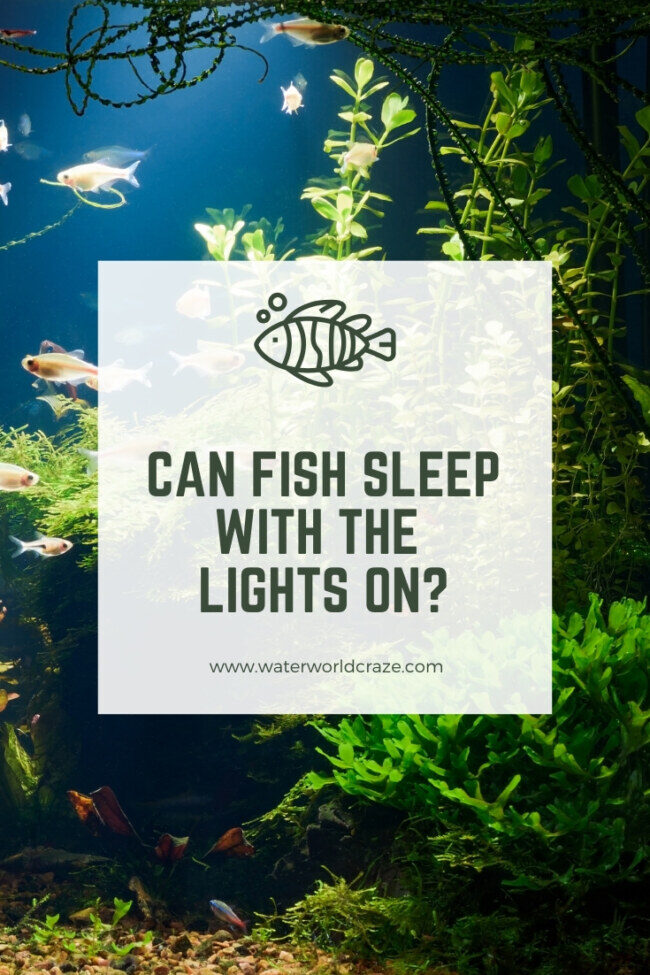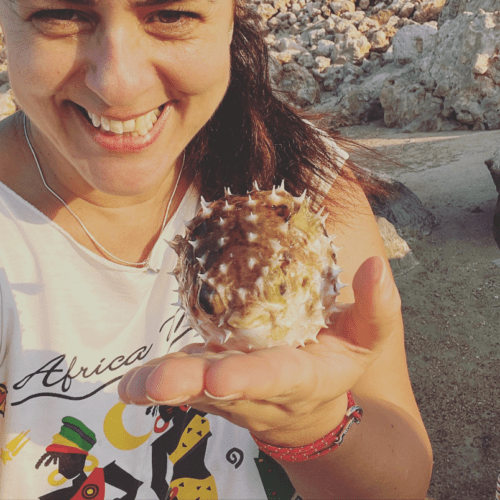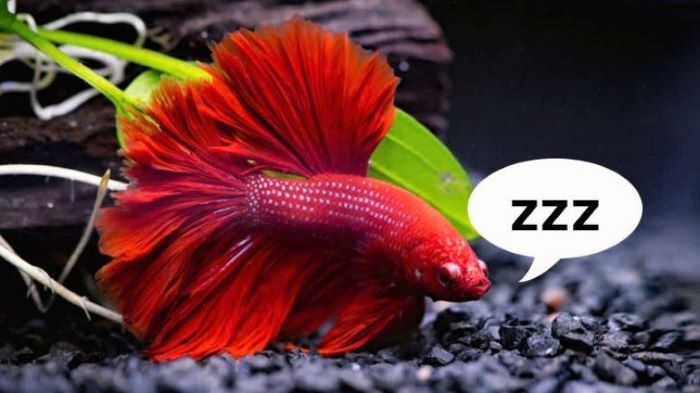 Not all fishes have eyelids to indicate they are sleeping, except for sharks. They sleep with their eyes open (a technique that would have been so useful to us humans in boring situations). So, can fish sleep with the lights on?
Not all fishes have eyelids to indicate they are sleeping, except for sharks. They sleep with their eyes open (a technique that would have been so useful to us humans in boring situations). So, can fish sleep with the lights on?
The short and quick answer to it is no, they cannot. It disturbs their biorhythmic cycle, as light is a big indicator of their sleep and wake cycle. Keeping the lights on will keep them ‘awake’ and it will lead to sleeping, behavioral, and health disorders. Hence, they should be getting their beauty sleep at night just like we all do.
Since fishes sleep with their eyes open, people who are new in the fish keeping community might consider them to be awake all the time. But how do fish ever sleep if their eyes are always open? Would your room-light disturb their sleep? Let’s explore all these aspects.
Table of Contents
Keeping Their Eye Open For Threat
One of the reasons why fishes do not look like they are sleeping is because they do not have eyelids. We can perceive others to be sleeping when their eyelids are closed.
Since fishes do not have it, it is common to mistake them as being ‘awake’ all the time. However, there is a distinction to make here – they never have their REM sleep.
To understand their ‘sleep’, you have to understand their brain structure and survival mode. Fishes, especially smaller ones, are prone to be eaten by any predatory animal. Hence, they have to be more alert than the other species.
They are fully awake and alert in the daytime. But at night time, they prefer to hide anywhere they find to be safe and ‘sleep’.
Now, some fishes will form a group and go in hiding together to feel safer when they sleep. Some will be lone rangers. They will go to the bottom of the sea or aquarium and hide behind plants and lush.
The idea is to be swimming gingerly in one place and take naps. They do not sleep as we do. They are prone to sleep in breaks than at full stretch.
When they are in their deep sleep time, they tend to go ‘blind’ to their surroundings – just like when we daydream. You can even catch a fish (without disturbing it or touching it) and shift it to another tank –and it will still be sleeping.
An alert fish will be swimming and showing some kind of movement or resistance to the move.
Just like us humans, fishes are prone to get irritated, get jittery, or get insomnia when their sleep cycle is disturbed.
Fishes deliberately wreck their sleep cycle if they are migrating or spawning or when they are taking care of their fry. This can make them aggressive for a while but it is rather temporary and small in impact.
Chronic sleep deprivation can make them lethargic, lose orientation, affect their health, and pick up a fight with other fishes in the tank. A lot of it has to do with the light they get in their aquarium.
If your fish are fighting, we highly recommend reading this article! It shows you 8 reasons why your fish are fighting and how to stop it!
Sleep And Its Relation To Light
Light affects most of the living organism’s biorhythmic cycle on the earth, including ours. Daylight indicates the body to wake up and be alert and the absence of it prepares the body to rest.
The main aim of sleeping (or even taking continual naps when we talk about fishes) is to replenish the body and mind. If one gets too much or too little of it, the body and mind suffer. This holds true for fishes as well.
Keeping the lights on for too long or keeping the lights too bright for some of the sensitive species can cause them to feel disoriented. Not only that, algae will start to flourish at twice the speed.
At one point, fishes and algae will be fighting for their spot in the aquarium. Some lights might even cause a change in temperature and this can affect your fishes as well as aquatic plants. Too much sunshine indeed creates a desert.
Fishes will sleep when you turn the lights off. Just make sure they get 12 hours of daylight and prepare for sleep by nighttime.
Interior fish lights are necessary for some species of fishes and aquatic plants, especially when your area doesn’t get a sufficient amount of light indoors.
Goldfishes are known to lose color if they do not get sufficient light. If you have corals and plants in the same setting, the requirements can get even more specific. We shall jump into that topic next.
But before we get there, there is one more question that one might be curious to know – do fishes get disturbed by your room’s light? Does light and sound from your television cause sleep disturbance to your fishes?
It depends mostly on the species of the fishes and the environment you create for them. If you have fishes that are habitual of riverside and seaside, they may be able to tolerate a quite decent amount of television volume and sleep comfortably.
But if you have fishes who come from more quieter areas, they might need more peaceful silence.
Even though sound travels faster in water than in air, it will not cause any disturbance to the fishes, as there is a barrier between the two medium – the glass tank.
If you create any noise source inside of the tank, they will get highly disturbed, but they cannot be much disturbed by the outside noise. However, you shouldn’t be listening to deep bass, as its effect can penetrate in water and disturb their sleep.
When it comes to room lights, do not keep it on when they are sleeping. If it is absolutely necessary to put the light on in the same room they are sleeping, put a thick blanket over the tank so that they do not get disturbed.
Types Of Lights For Your Aquarium And How To Choose The Best One
There are 2 types of tanks that a hobbyist mostly keeps:
- Freshwater tank
- Saltwater tank
There are subtypes to both types of water tanks:
- Fish only tank (only fishes and no other aquatic species. Level: Beginner)
- Fishes with only live rock tank (introducing plants, sponges, invertebrates, and others in the tank. Level: Intermediate to expert)
- Reef tank marine aquarium (little to no fishes, mostly corals, and invertebrates. Level: expert)
You can mix and experiment with the lighting system only when you have full knowledge of the species you have in your tank and if you have a genuine enthusiasm for it. Else, improper lighting can ruin everything.
Find lights that are in your budget and are relevant to the dimensions of the tank.
A fish-only tank will require a simple lighting system without getting too fancy. However, fishes with only live rock and reef tanks need very specific light requirements.
There are four main types of aquarium lights available.
Normal Output Fluorescent Lighting
Normal output fluorescent lighting or standard fluorescent lighting is ideal for freshwater and fish-only saltwater tanks. They are enough to illuminate a tank efficiently.
There are other popular variants of these fluorescent lights that have different light-emitting qualities.
- Actinic White Bulbs – Helps in mimicking marine type light and environment. Helps in coral growth for reef tanks
- Color enhancing bulbs – Ideal for a fish-only tank (both saltwater and freshwater). It helps in enhancing the glow of the whole aquarium and the fishes.
- Plant bulbs – Ideal for fish with live rock settings or settings where there are plants that need photosynthesis.
- Daylight bulbs – Used to mimic natural sunlight. Ideal for both saltwater and freshwater aquarium
- High-intensity bulbs – Ideal for marine aquariums and stimulates deep marine light conditions.
Compact Fluorescent Lighting (CFL)
CFL produces double the amount of light as compared to standard fluorescent lights and is more operating friendly.
You get the same benefits as the former but with less amount of lighting equipment. It is ideal for both freshwater and marine aquariums.
High-Intensity Metal Halide Lighting
Metal halides lightings are efficient for lightening aquariums that are deeper than 24 inches. Other light sources may not be able to illuminate effectively at deeper levels of water and this is where metal halides lightings come in handy.
Light Emitting Diode (LED)
LED lights are almost new in the aquarium lighting field but they are doing an efficient job in emitting light at less amount of energy. It may be a little costly initially but it saves your money and energy in the long run.
It is good for a fish-only tank for both freshwater and saltwater tanks. More research needs to be done if they are really efficient for other types of tank given that we can also control the color temperature with LED lights.
In any case, make sure you make an informed choice about the lights you choose with respect to the aquatic species you have, tank size, tank type, and your budget.

Marta, the driving force behind WaterWorldCraze.com, holds a Master’s degree in Marine Biology and has extensive experience in water sports and activities. With over 7+ years of hands-on experience in marine research and conservation, she has participated in numerous underwater expeditions and projects. Her passion for the aquatic world shines through in her expertly curated content. Join Marta as she explores the wonders of marine life and shares her adventures. Connect with her on Instagram @marinebiologymarta for more insights and updates.

